NVIDIA’s GeForce GTX 480 and GTX 470: 6 Months Late, Was It Worth the Wait?
by Ryan Smith on March 26, 2010 7:00 PM EST- Posted in
- GPUs
Image Quality & AA
When it comes to image quality, the big news from NVIDIA for Fermi is what NVIDIA has done in terms of anti-aliasing of fake geometry such as billboards. For dealing with such fake geometry, Fermi has several new tricks.
The first is the ability to use coverage samples from CSAA to do additional sampling of billboards that allow Alpha To Coverage sampling to fake anti-alias the fake geometry. With the additional samples afforded by CSAA in this mode, the Fermi can generate additional transparency levels that allow the billboards to better blend in as properly anti-aliased geometry would.
The second change is a new CSAA mode: 32x. 32x is designed to go hand-in-hand with the CSAA Alpha To Coverage changes by generating an additional 8 coverage samples over 16xQ mode for a total of 32 samples and giving a total of 63 possible levels of transparency on fake geometry using Alpha To Coverage.
In practice these first two changes haven’t had the effect we were hoping for. Coming from CES we thought this would greatly improve NVIDIA’s ability to anti-alias fake geometry using cheap multisampling techniques, but apparently Age of Conan is really the only game that greatly benefits from this. The ultimate solution is for more developers of DX10+ applications to enable Alpha To Coverage so that anyone’s MSAA hardware can anti-alias their fake geometry, but we’re not there yet.
So it’s the third and final change that’s the most interesting. NVIDIA has added a new Transparency Supersampling (TrSS) mode for Fermi (ed: and GT240) that picks up where the old one left off. Their previous TrSS mode only worked on DX9 titles, which meant that users had few choices for anti-aliasing fake geometry under DX10 games. This new TrSS mode works under DX10, it’s as simple as that.
So why is this a big deal? Because a lot of DX10 games have bad aliasing of fake geometry, including some very popular ones. Under Crysis in DX10 mode for example you can’t currently anti-alias the foliage, and even brand-new games such as Battlefield: Bad Company 2 suffer from aliasing. NVIDIA’s new TrSS mode fixes all of this.

Bad Company 2 DX11 Without Transparency Supersampling
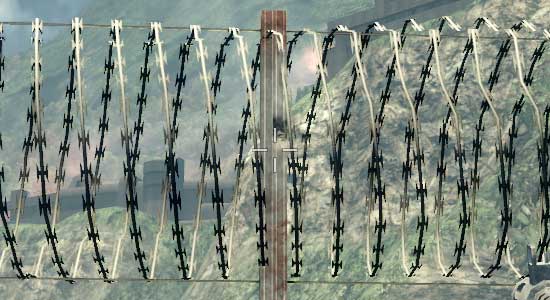
Bad Company 2 DX11 With Transparency Supersampling
The bad news is that it’s not quite complete. Oh as you’ll see in our screenshots it works, but the performance hit is severe. It’s currently super-sampling too much, resulting in massive performance drops. NVIDIA is telling us that this should be fixed next month, at which time the performance hit should be similar to that of the old TrSS mode under DX9. We’ve gone ahead and taken screenshots and benchmarks of the current implementation, but keep in mind that performance should be greatly improving next month.
So with that said, let’s look at the screenshots.

| NVIDIA GeForce GTX 480 | NVIDIA GeForce GTX 285 | ATI Radeon HD 5870 | ATI Radeon HD 4890 |
| 0x | 0x | 0x | 0x |
| 2x | 2x | 2x | 2x |
| 4x | 4x | 4x | 4x |
| 8xQ | 8xQ | 8x | 8x |
| 16xQ | 16xQ | DX9: 4x | DX9: 4x |
| 32x | DX9: 4x | DX9: 4x + AAA | DX9: 4x + AAA |
| 4x + TrSS 4x | DX9: 4x + TrSS | DX9: 4x + SSAA | |
| DX9: 4x | |||
| DX9: 4x + TrSS |
With the exception of NVIDIA’s new TrSS mode, very little has changed. Under DX10 all of the cards produce a very similar image. Furthermore once you reach 4x MSAA, each card producing a near-perfect image. NVIDIA’s new TrSS mode is the only standout for DX10.
We’ve also include a few DX9 shots, although we are in the process of moving away from DX9. This allows us to showcase NVIDIA’s old TrSS mode, along with AMD’s Adapative AA and Super-Sample AA modes. Note how both TrSS and AAA do a solid job of anti-aliasing the foliage, which makes it all the more a shame that they haven’t been available under DX10.
When it comes to performance, keep in mind that both AMD and NVIDIA have been trying to improve their 8x MSAA performance. When we reviewed the Radeon 5870 back in September we found that AMD’s 8x MSAA performance was virtually unchanged, and 6 months later that still holds true. The performance hit moving from 4x MSAA to 8x MSAA on both Radeon cards is roughly 13%. NVIDIA on the other hand took a stiffer penalty under DX10 for the GTX 285, where there it fell by 25%. But now with NVIDIA’s 8x MSAA performance improvements for Fermi, that gap has been closed. The performance penalty for moving to 8x MSAA over 4x MSAA is only 12%, putting it right up there with the Radeon cards in this respect. With the GTX 480, NVIDIA can now do 8x MSAA for as cheap as AMD has been able to
Meanwhile we can see the significant performance hit on the GTX 480 for enabling the new TrSS mode under DX10. If NVIDIA really can improve the performance of this mode to near-DX9 levels, then they are going to have a very interesting AA option on their hands.
Last but not least, there’s anisotropic filtering quality. With the Radeon 5870 we saw AMD implement true angle-independent AF and we’ve been wondering whether we would see this from NVIDIA. The answer is no: NVIDIA’s AF quality remains unchanged from the GTX200 series. In this case that’s not necessarily a bad thing; NVIDIA already had great AF even if it was angle-dependant. More to the point, we have yet to find a game where the difference between AMD and NVIDIA’s AF modes have been noticeable; so technically AMD’s AF modes are better, but it’s not enough that it makes a practical difference
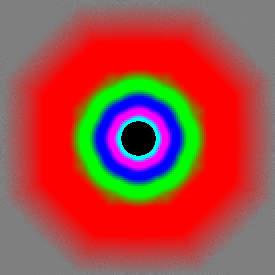
GeForce GTX 480

GeForce GTX 285
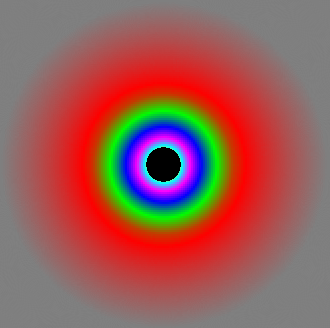
Radeon 5870


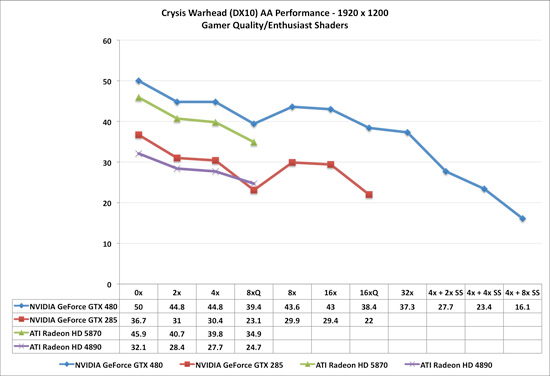
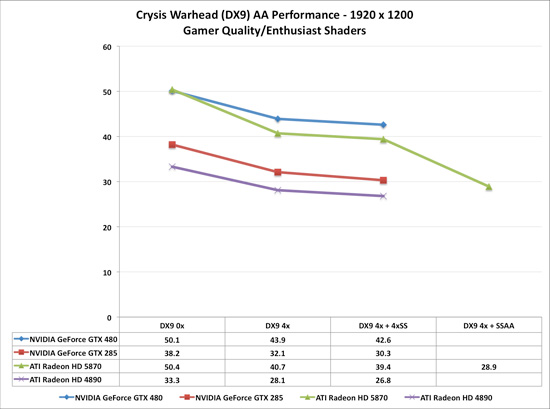








196 Comments
View All Comments
palladium - Saturday, March 27, 2010 - link
clock for clock, the 920 is faster than the 860 thanks to its triple channel memory - the 860 is faster because of its aggressive turbo mode. X58 is definitely the route to go, espeacially if you're benchmarking SLI/CF setups (dual PCIe x16).randfee - Sunday, March 28, 2010 - link
go ahead and try Crysis with 3,33GHz and 4,x, minimum fps scale strangely with the CPU.palladium - Saturday, March 27, 2010 - link
shit double post, srypalladium - Saturday, March 27, 2010 - link
Clock for clock, the 920 is faster than the 860 (860 is faster because of its aggressive turbo mode). Using the P55/860 would limit cards to PCIe x8 bandwidth when benchmarking SLI/CF (unless of course you get a board with nF200 chip), which can be more significant (espeacially with high-end cards) than a OC-ing a CPU from 3.33GHz to 4GHz.Roland00 - Saturday, March 27, 2010 - link
It doesn't really add to the framerates, and having a 4ghz cpu could in theory bring stability issues.http://www.legionhardware.com/articles_pages/cpu_s...">http://www.legionhardware.com/articles_...scaling_...
B3an - Friday, March 26, 2010 - link
You're good at making yourself look stupid.A 920 will reach 4GHz easy. I've got one to 4.6GHz. And a 920 is for the superior X58 platform and will have Tri-Channel memory.
Makaveli - Friday, March 26, 2010 - link
I have to agree with that guy.Your post is silly everyone knows the X58 platform is the superior chipset in the intel line up. Secondly do you honestly think 3.33Ghz vs 4Ghz is going to make that much of a difference at those high resolutions?
randfee - Friday, March 26, 2010 - link
sorry guys but I know what I'm talking about, using Crysis for instance, I found that minimum fps scale quite nicely with CPU clock whereas the difference a quad core makes is not so big (only 2 threads in the game afaik). FarCry 2, huge improvements with higher end (=clocked) cpus. The Core i7 platform has a clear advantage, yes, but the clock counts quite a bit.As I said... no offense intended and no, not arguing against my favorite site anandtech ;). Just stating what I and others have observed. I'd just always try and minimize other possible bottlenecks.
randfee - Friday, March 26, 2010 - link
well.... why not test using the 920 @ 4.xGHz, why possibly bottleneck the System at the CPU by using "only" 3,3?No offense intended but I find it a valid question. Some games really are CPU bound, even at high settings.
Ph0b0s - Friday, March 26, 2010 - link
These new cards from ATI and Nvidia are very nice and for a new PC build it is a no brainer, to pick up one of these cards. But for those like me with decent cards from the last generation (GTX285 SLI) I don't really feel a lot of pressure to upgrade.Most current PC games are Directx 9 360 ports that last gen cards can handle quite well. Even Directx 10 games are not too slow. The real driver for these cards are Directx 11 games, the amount of which I can count on one hand and not very many upcomming.
Those that are out don't really bring much over DX10 so I don't really feel like I am missing anything yet. I think Crysis 2 may change this, but by it's release date there will probably be updated / shrunk versions of these new GPU's avaliable.
Hence why Nvidia and ATI need really ecstatic reviews to convince us to buy their new cards when there is not a lot of software that (in my opinion) really needs them.